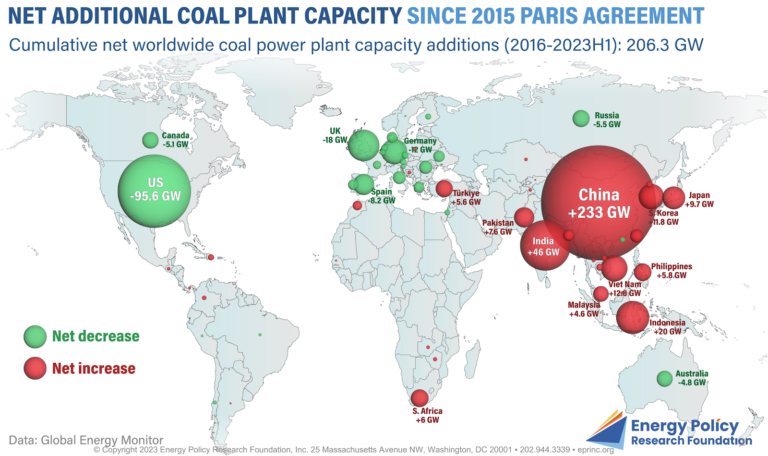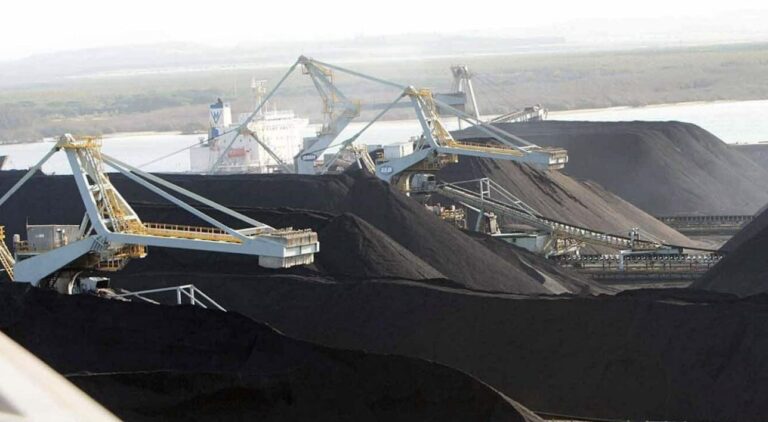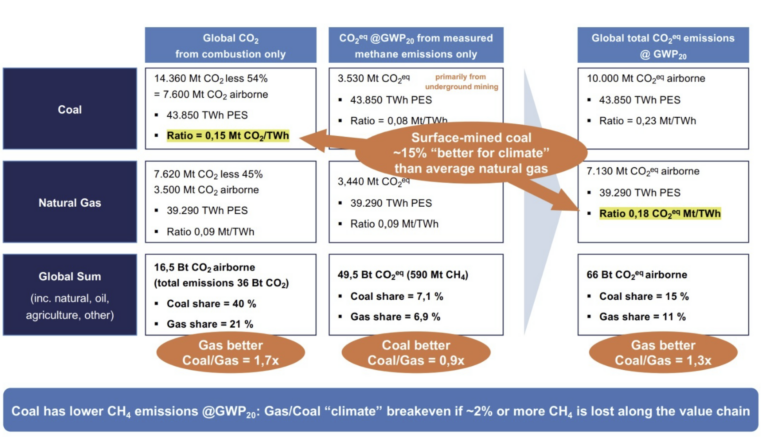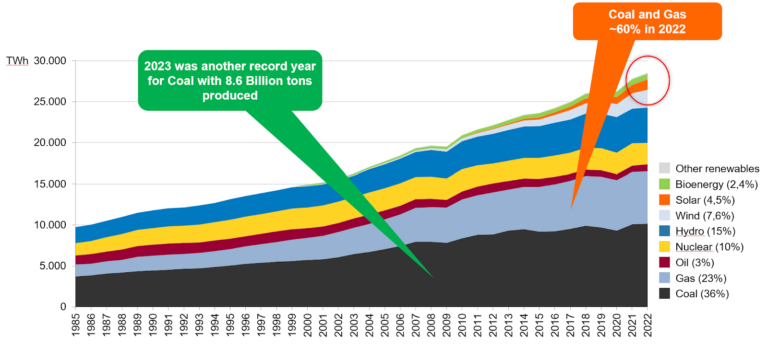Why South Africa should not walk away from Coal
Full article can be found at South Africa´s ‘Independent Online’
“With coal almost any feat is possible or easy; without it we are thrown back into the laborious poverty of early times.” (The Coal Question William Stanley Jevons, 1865).
Is this quote still valid, almost 160 years later?
Coal is globally, and certainly for South Africa, the most important source of power. The commodity is required for almost every product and structure that we see around us and use every single day, either directly or indirectly. There is virtually no machine, cement, steel, aluminium, building, car, computer, iPhone, or even a solar panel or windmill that can be created without coal.
Yet coal unfortunately doesn’t seem to have many friends but let us have a closer look as to why it deserves our admiration.
Figure: 206 GW Cumulative Net Coal Plant Capacity Additions since Paris Agreement 2016 until H1 2023, Source: Global Energy Monitor, EPRINC,” Nov 2023, https://eprinc.org/chart-of-the-week/
South Africa’s Struggle with Power and Coal
Amidst the ongoing discussions surrounding the finalization of South Africa’s 2023 Integrated Resource Plan (IRP2023), it is imperative for South Africa’s business elite, media, and various political parties to reassess their positions and understanding of the consequences of an anticipated move away from coal.
The warnings of many engineers, economists and other experts within the energy sector that South Africa won’t easily walk away from coal has already played itself out in the political scene in 2023 when the Minister of Mineral Resources and Energy, Gwede Mantashe, a former coal miner, called the just energy transition that advocated for a rapid transition towards “renewable” energy only, “a foreign concept”. In response to his stance, the ANC led government, presumably under the pressure of international investors and the media, created a new portfolio titled Minister of Electricity that was headed by Dr. Kgosientsho Ramokgopa who holds a qualification in civil engineering. He initially recommitted to the “green transition”, but shortly after the closure of the Komati Coal Power Station, he also joined the chorus and started speaking out against “the end of coal”. The blowback was felt throughout the corridors of power to the extent that even the Presidential Climate Commission, a body that is stacked with conflicted environmental lobbyists, who crafted the policies that advocate for the closure of the coal-fired power station, admitted that “little attempt had been made to consult with workers”.
The Democratic Alliance, the official opposition who is South Africa’s de facto green party, did not fare better. Despite having an official position “against coal”, the DA mayor of Pretoria, Mr. Cilliers Brink’s spokesperson, Sipho Stuurman, recently announced that the city intends on bringing back the 300 MW Rooiwal Coal Power Station for at least 10 years. Brink’s revelation came only a few months after the announcement of his 2050 “Net Zero” Strategy that presumably foresees “the end of coal”.
Even though critics have accused the ANC leadership of “fake news”, and exaggerating the situation, it’s worth reflecting on both the above events and ask why it is so difficult for South Africa to simply “walk away from coal”. Interestingly, as South Africa’s government utility Eskom faces challenges to keep the lights on, a pragmatic energy realism has emerged and for the first time since the end of Apartheid, the policy deviations do not appear to fall on traditional party lines. They are rather reminiscent of historical regional rivalries between the two power geographic centres, the “Transvaal”, and the “Cape Colony”. Taking the risk of generalization, the former has often been more pragmatic and sympathetic to the challenges of Africa, while the latter, in line with its historical traditions, appears to be “the joiners” that are more prepared to bow to the “anti-coal” dogma of the “Global North”.
Supporting coal is often viewed as a heretical form of “denial” of climatic changes and an “ignorance” of the “toxic” poisons spewing from coal plants. However, the reality is that (a) modern coal is not what it used to be (b) surface mined coal releases fewer green-house gas emissions than LNG imports, over the entire supply chain and (c) economic trade-offs and not ideological purism should be what drives the decision making in developing nations such as South Africa.
Note: PES = Primary Energy Supply
Source: Schernikau Illustration and calculations based on IEA, Our World in Data, IPCC (Ritchie and Roser, 2020a, 2020b)
As the world’s most coal-dependent country, South Africa’s government also bears a responsibility to the 4,5 million people in the Mpumalanga Region, safeguarding them from population stress and displacement during the “energy transition”, which actually has not even started globally. The issue furthermore involves various factions within the energy sector and is entangled in a passionate debate covering the restructuring of Eskom, the upcoming 2024 political elections, public frustration with load shedding, Eskom’s mismanagement, and geopolitical pressures from the western nations to commit to net zero policies.
The Global Coal Context
In a global context, coal has enormous value. The fuel, originating from plants that date back millions of years, retains its position as the most important source of electricity, constituting about 36% in 2023, and the second most crucial source of primary energy, accounting for approximately 25% share in 2023. As the graph below shows, its absolute volumes continue to set new records almost every year, despite a slight reduction in the global share of coal.
In 2023, approximately 8.6 billion tons of coal were consumed, and its significance for power generation in most developing nations appears to be increasing, as seen in many countries such as China, India, Bangladesh, Pakistan, Vietnam, Turkey, and elsewhere across the Global South in general, and South-East Asia in particular.
South Africa, being the country most globally dependent on coal, derives up to 80% of its primary energy and electricity from the commodity, a trend largely unchanged over the past two decades. The nation produces over 200 million tons per annum, with less than 70 million tons being exported in 2023, constituting less than 7% of global seaborne coal supplies.
In addition to electricity use, almost one third of all petrol in South Africa is derived from coal through SASOL’s Fischer-Tropes process and. Although in decline, up to 12% of all coal imports to the European Union in 2022 came from South Africa. South African coal is of a unique quality and the fly-ash was exported to locations like China, Saint Helena, Namibia, Egypt and the UAE – where notably the byproduct was used as a cement extender in the construction of the Burj Khalifa, the world’s tallest building. Coal also plays an important role as a source of the critical minerals that include aluminium, cobalt, copper, iron, lead, silver, nickel, and zinc.
Figure: Worldwide Electricity Production by Source, Schernikau based on BP Statistical Review of World Energy and Global Electricity Review (2023)
The Rainbow Nation, whether we want to acknowledge it or not, is therefore a coal country. Abandoning coal would have severe consequences for industry and people, and not only in comparison to its developing global peers. More importantly, if coal is not revived, the country would likely exacerbate rolling blackouts and potential social unrest. The move could prove to be callous and dangerous to those involved in the coal value chain.
The Department of Minerals and Energy (DMRE) has, in the IRP2023, contemplated extending the lifespan of the existing coal fleet, but they remain silent about the numerous abandoned coal power stations, constituting approximately 2,500 MW of power capacity. Even though its own data shows that restoring Eskom’s energy availability factor through more investment in coal might be the least cost option for the next 5 years, DMRE appears to not consider this pathway. Why?
Neglected coal facilities, including Duvha 3, Hendrina, Grootvlei, Rooiwal, Pretoria West, and Kelvin Power Station, demand attention. Bringing them back online could be done in 18 to 36 months if a competent and empowered engineering team is dispatched. It remains the quickest and lowest-cost way to alleviate load shedding. All alternatives lack reliability, affordability, and/or have longer lead times.
We argue that South Africa should consider not only bringing back abandoned coal power stations, but the leadership should unapologetically make a commitment in law to continue the investment in coal, at least for two decades. Our recommendation is based on the following undisputed, yet unpopular, facts about coal, most of which do not only apply to South Africa:
Cost-effective and abundant: Coal remains the cheapest (at full system cost), safest, simplest, most secure, easiest to store and transport, and most abundant energy source available.
Proven combustion technology: Combustion technology for coal is well-established, and advanced ultra-supercritical power plants are exceptionally clean, meeting high environmental standards.
Global energy contribution: Coal contributes to 36% of global power and 25% of total energy, making it unwise, dangerous, and potentially life-threatening to dismiss it.
Industrial backbone: Coal is the cornerstone of South Africa’s, or any nations industrial economy, supporting various applications such as steel, cement, chemicals, dynamite, mining, and photovoltaic expansion.
Geopolitical stability: Coal demonstrates geopolitical stability, as evidenced by Europe’s ability to swiftly replace Russian coal after the invasion of Ukraine.
“Independence from nature: Coal is not reliant on natural conditions, making it a dependable energy source that is unaffected by weather conditions. With an availability rate close to 100%, there is no need for storage, batteries, hydrogen, or backup in the form of idle power plants. A standard 20% reserve margin ensures virtually 100% availability.
Quick ramp-up and down: Coal exhibits rapid adjustability, approaching the efficiency of gas power. This flexibility is crucial for adapting to fluctuating energy demands.
Lower utilization without efficiency loss: Coal-fired power stations can operate at much lower utilization levels compared to gas power plants, offering flexibility without significant efficiency loss—a notable advantage.
“Climate impact”: When assessing the full supply chain, most liquified natural gas LNG to have a larger “global warming impact” than coal, according to the IPCC’s and IEA’s own data.
Advanced technologies: The Newest coal-fired power stations globally demonstrate how advanced combustion technology is today. High-Efficiency Low Emissions (HELE) advanced ultra-supercritical coal technology can significantly enhance combustion efficiency, reducing emissions or environmental impact per unit of energy. If CO2 requires to be captured, CO2 capture from a 15% CO2-stream is amongst the lowest cost options available.
Specific to South Africa
Challenges in rapid transition: South Africa’s heavy dependence on coal would make a rapid transition away not only challenging but unrealistic, until a truly economically and environmentally sustainable alternative at grid scale becomes available.
Infrastructure Challenges: South Africa is confronted with obstacles in adopting alternative storage or backup options, including pumped storage, natural gas, and nuclear power. The extensive transmission infrastructure, covering 14,000 km (equivalent to 40% of the distance around the world), required for widespread wind and solar integration poses a significant challenge, especially considering the current expansion rate of only 600 km per year. Investing in the coal value chain can be implemented promptly, leveraging established railway lines, and grid systems.
Localization: Utilizing coal domestically and transporting it by railway instead of trucks will eliminate foreign currency implications and contribute positively to employment. Implementing a policy that mandates the use of coal on railways will further protect highways and aid in the maintenance and improvement of Transnet’s infrastructure.
Amortized Assets: Given that the capital expenditure has already been paid off and considering the current global high-interest-rate environment, coal life extensions are expected to have a lower Weighted Average Cost of Capital (WACC) compared to new infrastructure builds. Interest rates and material price inflation has already resulted in rising costs of “renewable” electricity in the country.
In Summary
It is essential for South Africa to adopt a balanced and realistic approach, recognizing that coal continues to play a pivotal role in the domestic and global electricity and energy mix and for industrial development. The coexistence of clean coal with emerging “renewable” technologies could ensure a stable, secure, and sustainable energy future for the country. It must be noted that, today, there is not one single solar panel on the market that would be possible to be produced without coal, as such, if solar panels are not “net-zero” even as per the IPCC, then what is?
The potential overhaul of South Africa’s entire coal fleet has incredible benefits for traditional social democratic development. As a general rule, up to 2 Rand is returned for every 1 Rand invested in megaprojects. In contrast, by demonizing coal, South Africa is likely to be the country that is going to incur the most self-harm and deprive future generations of the highest opportunity cost, because the coal supply chains are already so integrated into the industrial economy.
South Africa should rather consider adopting an energy path similar to India, China and Japan. The latter country being the only G7 nation whose leadership has committed in law to not phasing out coal but rather to continue expanding it. Drawing inspiration from Japan’s elite, who, mindful of the Meiji Restoration’s historical significance, recognize that their country’s prosperity, much like South Africa’s, is built on the coal mining industry.
Policy initiatives should prioritize technological advancements, advocating for a shift away from the prevailing impossible “net-zero” doctrine2 that, as a consequence, would tear down established industries, Germany being a sad example.
South Africa should rather embrace good old King Coal as part of its energy future by supporting investments to improve environmental and economic efficiencies.
Full article can be found at South Africa´s ‘Independent Online’
About The Authors
Hügo Krüger is a YouTube podcaster, writer, and civil nuclear engineer with experience spanning the energy sector, including the design and construction of infrastructure for nuclear power, offshore wind, fly ash technology, and liquefied natural gas. He holds a BEng in Civil Engineering and an MSc in Nuclear Civil Engineering.
Dr. Lars Schernikau: Lars is an energy economists, commodity trader, entrepreneur, and author. He has worked in energy commodities globally and in Africa for over 20 years and has written several books and articles on commodities, coal, and energy markets. His most recent book “The Unpopular Truth about Electricity and the Future of Energy” is available in several languages globally.
SUBSCRIBE to Hügo`s newsletter





